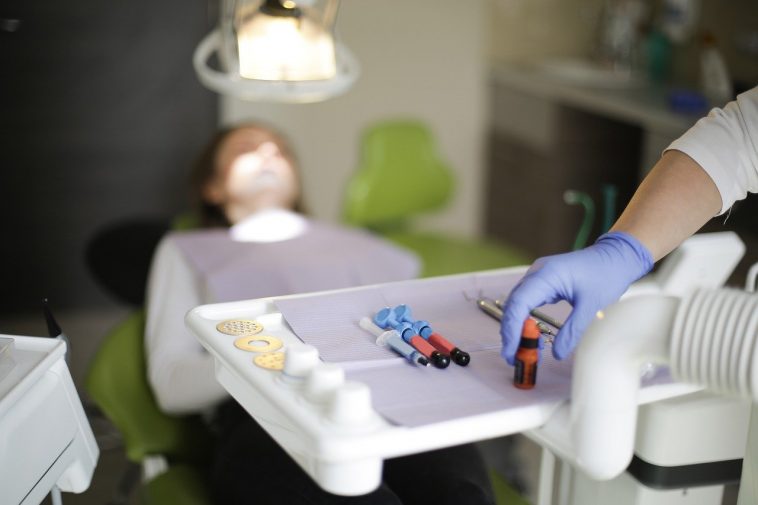When bone from the jaw (or another body part, such as the hip bone) is used to support a dental procedure, it’s known as a dental bone graft. This procedure can be useful in accomplishing certain oral health goals, such as supporting dental implants, depositing material into a tooth socket following an extraction, or saving teeth that are at risk of being lost. However, people that get dental bone grafts should be aware of the risk of infection following their procedure and take steps to prevent an infection from happening. Continue reading to learn more about what happens during a dental bone graft, how they can become infected, what you can do to prevent infection, and how you can ease any discomfort following your dental bone graft procedure.
What Happens During a Dental Bone Graft
During a dental bone graft, your jawbone is built up with either bone from another part of your body, artificial bone, or bone from a donor. It’s usually done to support dental implant procedures that require a strong jaw bone. Following a dental bone graft, the surrounding jawbone grows and fuses with the implant, which helps ensure that the implant stays in place.
A bone graft is required when you lack enough healthy natural bone in your mouth to support a dental implant. This lack of natural bone may be caused by defects in development, gum disease, trauma to the facial bone structure, void space following a tooth extraction, or bacterial infections that result in jawbone loss.
Dental bone grafts most often come from the bone in your chin. However, sometimes complications make it difficult for a dentist to extract bone from the face. If that’s the case, a dentist can extract bone from your hip or shin. However, shin and hip bone extraction require a stay in the hospital, which is much more than what is required for a chin bone extraction.
If grafting bone from your body is not an option, a dentist can take bone from other places, such as a cow or another human; it’s also possible to use synthetic materials.
Causes of Infections in Dental Bone Grafts
Dental bone grafts can get infected if they are not taken care of properly. If bacteria get into the graft, it can take over and cause complications that delay your healing. Bacteria can get into a dental bone graft in a few ways. One way that bacteria can get into a dental bone graft is if the dentist uses unclean dental tools during the procedure. Another way that bacteria can affect a dental bone graft is if the bone grafting material — whether it’s your bone, bone from a donor, or artificial grafting material — has bacteria on its surface when it is implanted. Improper care of the graft following the procedure can cause infections and other problems as well.
Can You Sue a Hospital For an Infection?
The answer is complicated. With the help of an attorney specializing in injuries, you can document the actions taken by the hospital, prove that they were indeed negligent, and recover a settlement or judgement depending on how much pain and suffering you went through, or how much work-related income you lost as a result. Keep in mind that hospitals have budgets set aside for these types of cases, so you will need a good lawyer, and you will need to strap in for a lengthy (at least a year) legal process.
Also, keep in mind that personal injury settlement amounts vary, and depending on the offer you receive from the medical institution, you may need to go to trial in order to get fair compensation. The amount of money you are awarded will cover past and future medical bills, lost income, and sometimes pain and suffering. If you didn’t miss any work, and if you can’t prove significant physical trauma, you will have a challenging time in court.
Can an Oral Surgeon Face Criminal Charges For Medical Malpractice?
In almost every circumstance, no. Surgical errors can happen, and that’s why civil courts exist. It’s very rare for a doctor to face criminal charges, and prosecutors would need to prove that the surgeon intentionally ignored common safety protocols, acted maliciously, showed up to work under the influence of drugs or alcohol, or behaved in an otherwise grossly negligent manner. Furthermore, criminal action is rarely taken against doctors unless a patient dies because of negligence.
How to Prevent a Dental Bone Graft Infection
The best thing that you can do to prevent infection following a dental graft procedure is to take proper care of it. Being diligent about taking good care of your dental bone graft can also reduce the other symptoms that emerge following a graft, which include bleeding, swelling, bruising, and pain.
Consider using an intraoral device to provide relief. A two-chamber design allows the inside of the device to freeze while the outside stays soft and cold; specially constructed tubes make it easy to breathe during use. These devices can be used multiple times per day to alleviate pain throughout the post-surgery healing process.
After a dental bone graft, you should take the antibiotics that your dentist prescribed to prevent infection. This is one of the most important things you can do to keep your dental bone graft infection-free. If your dentist also prescribed pain medication, you should take that as well.
You can also prevent an infection by practicing good oral hygiene. Beginning the day after your surgery, use a gentle, warm saltwater rinse, and continue doing that a few times per day, especially after you eat food. This rinse will reduce the chances of inflammation and help keep food particles from interfering with the healing of the graft. Continue brushing your teeth as normal, but be careful about disturbing the healing tissue.
Restricting activity and being careful about how you use your mouth is another way to avoid infection. Only do what feels comfortable to you, and avoid exercise and other strenuous activities in the days following your procedure. Avoid touching or poking the grafted area at all costs, since bacteria on your hands is easily transferred to the grafted area. Only eat foods that are a moderate temperature and have a soft texture; you can add in solid foods at hotter temperatures as the graft heals. Eating anything that is too crunchy can open the wounded area, which can make an infection more likely.
Cooling Mouthpiece for Helping with Dental Pain After a Graft
It’s important to be diligent about taking care of your dental bone graft following a procedure if you’d like to avoid an infection. Make sure that you follow all of the care instructions provided by your dentist or oral surgeon, and know that you can relieve any pain or discomfort with the use of a cold therapy device.




